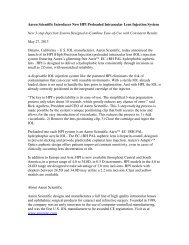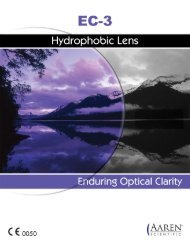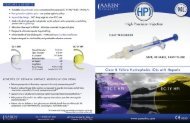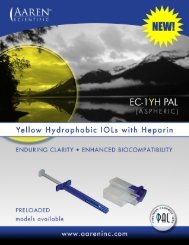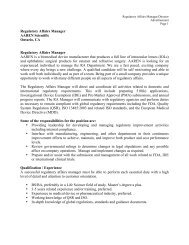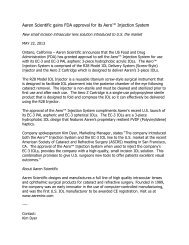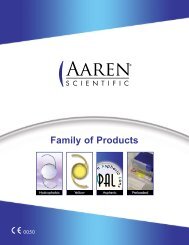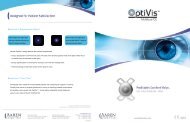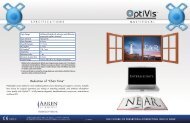Hydrophobic Acrylic IOLs: A Primer - Aaren Scientific
Hydrophobic Acrylic IOLs: A Primer - Aaren Scientific
Hydrophobic Acrylic IOLs: A Primer - Aaren Scientific
Create successful ePaper yourself
Turn your PDF publications into a flip-book with our unique Google optimized e-Paper software.
COVER STORY(personal communication with Benz Research &Development).Artis. Results are available for 20 consecutive eyesimplanted with the Artis (follow-up, 60 days). These <strong>IOLs</strong>were implanted in five centers by five surgeons through asub-2–mm incision (1.7 mm). The refractive results werewithin ±0.50 D of intended correction and remained stable.No glistenings or any form of IOL opacification wasobserved. Due to the overall design—four haptic componentswith 5º angulation and a square optic edge, includingat the optic-haptic junctions—the IOL did not induceovalization of the capsular bag. Posterior capsular contactwith the optic was noted between 8 and 15 dayspostoperatively; thus far, no lens epithelial cell migrationhas been detected behind the IOL optic, and the totallytransparent anterior capsule is not attached to the IOL’santerior optic surface.CALCIFICATIONPostoperative surface or intraoptic deposition of calciumphosphate has been described in association withhydrophilic acrylic lenses. 22 The four major designsinvolved in the problem are the Hydroview (Bausch +Lomb), the MemoryLens, the SC60B-OUV (MedicalDevelopmental Research, Inc., Clearwater, Florida), andthe Aqua-Sense (<strong>Aaren</strong> <strong>Scientific</strong>).Calcium phosphate deposits have also been reportedto occur on the posterior optic surface of silicone lensesimplanted in eyes with asteroid hyalosis. 22 To the best ofour knowledge, no confirmed case of calcification ofhydrophobic acrylic lenses is described in the literature;therefore, postoperative calcification does not appear tobe an issue with hydrophobic acrylic materials.CONCLUSIONVarious hydrophobic acrylic <strong>IOLs</strong> have been launchedin the international market, with manufacturing trendsthat include one-piece platforms, a 360º square posterioroptic edge with attention to the barrier effect at thelevel of the optic-haptic junctions, and incorporation ofblue-light–filtering chromophores. A photochromicIOL, filtering blue light only under photopic conditions,is also available.All hydrophobic acrylic lenses are not manufacturedfrom the same materials or using the same processes.Therefore, each lens exhibits different characteristics,including refractive index, water content, and tendencyfor glistenings formation. In terms of PCO formation, itappears that the square posterior optic edge is the mostimportant IOL design factor for prevention of this complication.However, all square edges in the market are notequally square. Only long-term clinical studies will indicateif there is superiority of a particular hydrophobicacrylic IOL over others. ■Nick Mamalis, MD, is a Professor and the Director of theIntermountain Ocular Research Center, John A. Moran EyeCenter, University of Utah, Salt Lake City. Dr. Mamalisstates that he is a paid consultant to Abbott MedicalOptics Inc. He may be reached at e-mail:nick.mamalis@hsc.utah.edu.Steele McIntyre, MD, is an ophthalmic research andpathology fellow at the Intermountain Ocular ResearchCenter, John A. Moran Eye Center, University of Utah, SaltLake City. Dr. McIntyre states that he has no financialinterest in the products or companies mentioned. He maybe reached at e-mail: steelemcintyre@hotmail.com.Liliana Werner, MD, PhD, is an Associate Professor andthe Co-Director of the Intermountain Ocular ResearchCenter, John A. Moran Eye Center, University of Utah, SaltLake City. Dr. Werner states that she is a paid consultant toPowervision and Abbott Medical Optics Inc. She may bereached at e-mail: liliana.werner@hsc.utah.edu.1.Leaming DV.Practice styles and preferences of ASCRS members—2003 survey.J Cataract Refract Surg.2004;30:892-900.2.Tjia KF.<strong>Hydrophobic</strong> acrylic <strong>IOLs</strong>.A new generation of these lenses is now available in Europe.Cataract & RefractiveSurgery Today Europe.2010;7:12-13.3.Werner L.Glistenings and surface light scattering in intraocular lenses. J Cataract Refract Surg.2010;36:1398-1420(Review).4.Abela-Formanek C, Amon M, Schild G, Schauersberger J, Heinze G, Kruger A.Uveal and capsular biocompatibility ofhydrophilic acrylic, hydrophobic acrylic, and silicone intraocular lenses.J Cataract Refract Surg.2002;28:50-61.5.Werner L, Pandey SK, Escobar-Gomez M,Visessook N, Peng Q, Apple DJ.Anterior capsule opacification:Ahistopathological study comparing different IOL styles. Ophthalmology.2000;107:463-471.6.Kohnen T, Fabian E, Gerl R, et al.Optic edge design as long-term factor for posterior capsular opacification rates.Ophthalmology.2008;115:1308-1314.7.Werner L, Mamalis N, Izak AM, et al.Posterior capsule opacification in rabbit eyes implanted with 1-piece and 3-piece hydrophobic acrylic intraocular lenses.J Cataract Refract Surg.2005;31:805-811.8.Nishi O, Nishi K.Preventing posterior capsule opacification by creating a discontinuous sharp bend in the capsule.JCataract Refract Surg.1999;25:521-526.9.Boyce JF, Bhermi GS, Spalton DJ, El-Osta AR.Mathematic modeling of the forces between an intraocular lens andthe capsule.J Cataract Refract Surg. 2002;28:1853-1859.10.Werner L, Müller M,Tetz M.Evaluating and defining the sharpness of intraocular lenses.Microedge structure ofcommercially available square-edged hydrophobic lenses. J Cataract Refract Surg.2008;34:310-317.11.Hancox J, Spalton DJ, Cleary G, et al.Fellow-eye comparison of posterior capsule opacification with AcrySofSN60AT and AF-1 YA-60BB blue-blocking intraocular lenses. J Cataract Refract Surg.2008;34:1489-1494.12.Werner L,Tetz M.Edge profiles of current available intraocular lenses and recent improvements.Touch Briefings.2009;74-76.13.Sacu S, Findl O, Menapace R, Buehl W,Wirtitsch M.Comparison of posterior capsule opacification between the 1-piece and 3-piece Acrysof intraocular lenses.Ophthalmology.2004;111:1840-1846.14.Nixon D,Woodcock M.Pattern of posterior capsule opacification models 2 years postoperatively with two singlepieceacrylic intraocular lenses.J Cataract Refract Surg.2010;36:929-934.15.Sparrow JR, Miller AS, Zhou J.Blue light-absorbing intraocular lens and retinal pigment epithelium protection invitro. J Cataract Refract Surg.2004;30:873-878.16.Mainster MA.Intraocular lenses should block UV radiation and violet but not blue light.Arch Ophthalmol.2005;123:550-555.17.Werner L, Abdel-Aziz S, Cutler-Peck C, et al.Accelerated 20-year sunlight exposure simulation of a photochromicfoldable intraocular lens in a rabbit model.J Cataract Refract Surg.2011;37(2):378-385.18.Yamamura T, Kazama S, Sasaki M, Shinzato E, Shima C.Glistening, surface irregularity, tilting and decentration ofacrylic intraocular lenses. IOL&RS (Japanese).2004;18:157-162.19.Tetz MR,Werner L, Schwahn-Bendig S, Batlle JF.Prospective clinical study to quantify glistenings in newhydrophobic acrylic IOL.Paper presented at:The ASCRS Symposium on Cataract, IOL, and Refractive Surgery; SanFrancisco; April 3-8, 2009.20.Amzallag T.One-year European results for the EC-3 hydrophobic clinical trial:Material clarity and visual outcomes.Paper presented at:The ASCRS Symposium on Cataract, IOL, and Refractive Surgery; San Francisco; April 3-8, 2009.21.Bosc JM.Initial impressions and early clinical results of a new single-piece hydrophobic yello acrylic IOL.Paperpresented at:The ASCRS Symposium on Cataract, IOL, and Refractive Surgery; San Francisco; April 3-8, 2009.22.Werner L.Causes of intraocular lens opacification or discoloration.J Cataract Refract Surg. 2007;33:713-726(Review).44 CATARACT & REFRACTIVE SURGERY TODAY EUROPE MARCH 2011



